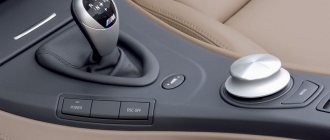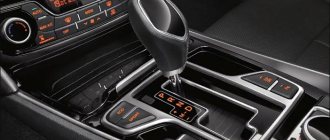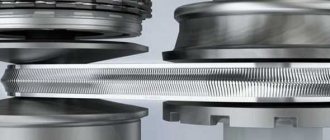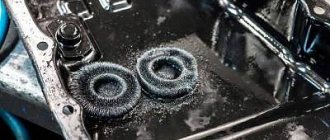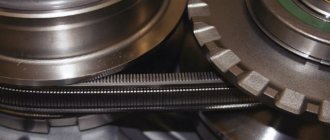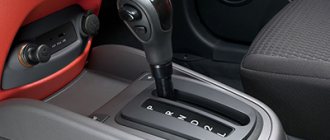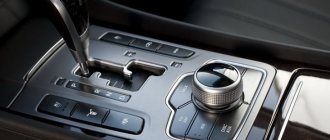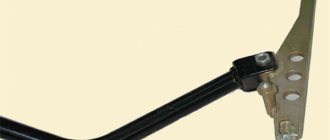Today, automatic transmission is at the peak of its popularity around the world. At the same time, manufacturers offer consumers various types of machines.
More precisely, there are hydromechanical automatic transmissions, CVT gearboxes, as well as robotic gearboxes with one clutch (AMT) and preselective robotic gearboxes with two clutches.
Each of these types of gearboxes differs from analogues in design, and also has certain advantages and disadvantages. In this article we will talk about the difference between a variator and a “classic” automatic transmission, what is the difference between an automatic transmission and a robot and a variator, etc.
Design and operation of the variator
The variator structurally consists of:
- driving/driven pulleys, shafts;
- steel belt;
- starting clutch (centrifugal, multi-disc, electromagnetic, torque converter);
- planetary gear satellite;
- oil pump;
- bearings;
- hydraulic unit;
- crankcase with magnets for filling transmission fluid;
- differential;
- planetary gearbox.
There are several types of variators. The most common among them is the V-belt mechanism. The pulleys in it consist of 2 cone-shaped disks with a slope towards the shaft axis. When moving, they are able to move or move apart.
A metal belt consisting of pushing segments is stretched and clamped between the halves of the variator pulleys (they create rotation by clinging to the body of the cones with a toothed surface). When the pulleys move apart, the belt goes inward, and when brought closer it takes on the shape of a wedge. The gear ratio changes by increasing or decreasing the diameters of the conical disks.
At the beginning of the movement, the cones of the driving pulley diverge, and the cones of the driven pulley converge. As speed increases, the reverse process occurs. As a result, the gear ratio changes downward, the traction force decreases, and the speed on the driven shaft increases.
The software part processes the information and changes the operating mode of the CVT variator. The differential distributes torque to the driving wheels of the car. The oil sump serves as a support and protection for the working mechanisms and is used to store transmission fluid, without timely replacement of which the variator will not last long.
By what signs can you determine that the variator has failed?
Signs of main variator failures:
slipping or inability to move away - malfunctions in the variator control module, a defect in the variator transmission (belt slipping between the pulley cones), malfunction of the torque converter, main drive clutch, electro-hydraulic system;
jumps and jerks during operation - the oil pump pressure relief valve is jammed;
stopping the car - wear on the torque converter pump wheel;
the car is moving in neutral - defects in the electrical wiring, gear selector, variator control module;
A hum unusual for a vehicle is the wear of the cone bearings.
The service life of a CVT variator depends on correct operation and regular maintenance. Manufacturers of CVT transmissions recommend changing the belt and transmission fluid in a timely manner (on average after 40 thousand kilometers).
We invite you to watch a video tip on how to operate a variator.
If you have no experience in solving problems with a variator, you can contact the “Cvariator Repair Center No. 1”. Our specialists will help you diagnose and fix problems in a short time. You can get additional information by calling: Moscow –, St. Petersburg – 8. We accept calls from all regions of the country.
CVT box
CVT device
Automatic transmission operation
A classic automatic transmission consists of:
- torque converter (clutch);
- planetary gearbox;
- hydraulic system;
- electronic control unit.
The automatic transmission works as follows:
- When the engine starts, the oil pump is activated to create liquid pressure in the AT.
- The pump wheel of the torque converter spins up at the speed of the crankshaft (the turbine and reactor wheels are stationary at this time).
- The driver presses the gas pedal and changes gears. The engine spins together with the pump wheel, from the blades of which oil is thrown towards the turbine, causing it to rotate. The lubricant then returns to the pump wheel and speeds it up.
- The oil passes through the machine's radiator.
- Free disks and gears rotate in a planetary gearbox (fixed clutches are attached to the box body).
- The electrical unit determines the vehicle speed and the load of the power unit based on sensor readings and transmits a signal to change gears to the valve body. The oil pump then supplies operating pressure to the hydraulic system channels.
- From the oil pump, the technical fluid passes to the valve body, the solenoid opens, passing it to the planetary link. The liquid presses on the pistons, compressing the friction discs.
- An element of the planetary gear, rigidly connected to the clutch (for example, a crown), is blocked; torque is transmitted through the carrier or sun gear. The rotation speed and transmitted force of the output shaft changes. At the same time, the elements of the previous transmission of the machine are unlocked.
Automatic transmissions with manual control mode (Autostick, Tiptronic) allow the driver to independently adjust the speed limit, but the switching process itself occurs under the control of the electric unit.
What machine malfunctions occur most often?
Malfunctions of the machine are expressed in the inability to switch gearbox operating modes or in the blocking of one of the gears. The causes of breakdowns may be in the mechanical and electronic parts of the automatic transmission. This:
Automatic transmission
malfunction of the torque converter and automatic locking clutch;
wear of shafts, gears, friction elements;
clogging of oil channels;
failure of the valve body and oil pump;
failure of the machine's actuators, control system sensors or controller;
breaks, short circuits in the electrical wiring of the machine.
The service life of the machine depends on the nature of the vehicle’s operation, timely and competent maintenance. In accordance with the recommendations of the vehicle manufacturer, it is necessary to periodically change the oil and regularly undergo diagnostics at a service station to monitor the condition of the oil receiver and radiator.
conclusions
All of the above will allow us to summarize and clearly outline the differences between a robotic gearbox and an automatic one.
The main differences are as follows:
- The robot has the ability to manually change gears, but the automatic does not have this ability.
- The robot is structurally similar to the mechanics; the automatic transmission has its own design.
- A robotic gearbox consumes less oil and fuel than an automatic gearbox.
- The automatic transmission outperforms the robotic gearbox in terms of smoothness and efficiency in operation.
- Repair work and maintenance of a robot are simpler and cheaper than that of an automatic machine.
- The automatic machine is considered more reliable in operation.
Drivers' opinions vary. Despite the obvious advantages of the robot, many car enthusiasts prefer an automatic. They believe that it is more predictable in its work and does not give “unpleasant surprises.” Modern designs of automatic machines are increasingly more economical, approaching the level of service of robots, being able to adapt to the driver’s style.
How does a manual transmission work?
The mechanics are simple. The body contains:
- primary, secondary, intermediate shafts with gears, additional shaft and reverse gear;
- synchronizer clutches;
- differential;
- crankcase;
- gear shift rod and fork;
- crankcase (half filled with transmission fluid).
On top of the box there is a gear selection mechanism with locking and locking devices. The gear shift lever is located in the cabin and is capable of moving in the longitudinal and transverse directions.
During operation, torque from the engine is transmitted through the clutch to the input shaft. The rotation speed is converted by the helical gears and then transmitted to the wheels. If the gear increases torque, then the engine speed decreases (and vice versa). In the classic case, 2 or 3 shafts are used for this.
The selection of the desired pair of gears to transmit the required torque under certain driving conditions is done using shift forks, which are driven by a selector.
Manual transmission
The following malfunctions are typical for manual transmissions:
knocking noise when driving and changing gears;
impossibility or difficulty of switching on speeds;
oil leak from the crankcase;
spontaneous switching off of gears.
Such problems arise due to wear of gearbox parts, loosening of fixing bolts and nuts, so a car with manual transmission requires timely maintenance.
Comparative characteristics of types of gearboxes
| Type of gearbox | Options | Resource (km) | Economical | Exploitation | Advantages | Flaws |
| Hydromechanical automatic | Depending on multi-stage | About 500,000 | High fuel consumption | Automatic is the best option for driving around the city (especially in traffic jams) | Versatility Ease of operation Large off-road capability Reliability Protection of the engine and chassis from overloads Maintainability | Slow acceleration Expensive maintenance |
| Variable speed drive | Weight 40-60 kg | On average 220,000 - 240,000 | Low fuel consumption | Driving around the city and on the autobahn | Quick acceleration Improved traction and no jerking during acceleration Smooth ride A large number of options for changing the gear ratio | The variator requires the use of special oil Cannot be repaired High maintenance costs Noise from operation is noticeable in the cabin |
| Robot | Depending on the drive, speed switching | Up to 250000 | Low fuel and oil consumption | Roads with good hard surface | Long service life Maintainability Low cost | Delay when switching gears Reduced service life when driving in traffic jams Clutch overheating Jerks and jerks when switching |
| Mechanics | Depends on the number of steps | Average 500000 | Average fuel consumption Low - oil | City limits Autobahn Off-road | Good acceleration High efficiency Quick winter starting Durability Unlimited towing and fast driving capabilities Low price | Difficulty of operation Possible overloads Constant use of the lever and pedals When starting, the car rolls back |
If you look at the table, which box do you think is better? Write in the comments.
What is better to choose
As you can already understand from the article, each type of transmission has its own pros and cons, and the choice must be made based on your personal capabilities and needs.
- If you prefer comfort and leisurely driving, then you should choose a car equipped with a CVT.
- For those who like reliability and frequent changes of car, a classic automatic is suitable. Cars of this type are the most popular in today's car market.
- An automatic robot with one disc can be a good solution for car enthusiasts who have limited financial resources but want to purchase a car with an automatic. Despite the low level of comfort, the motorist receives an inexpensive car with economical fuel consumption.
A robot with two disks should only be purchased new. When buying a used car, the owner must be prepared to soon replace or overhaul the robotic box, which means significant costs.
